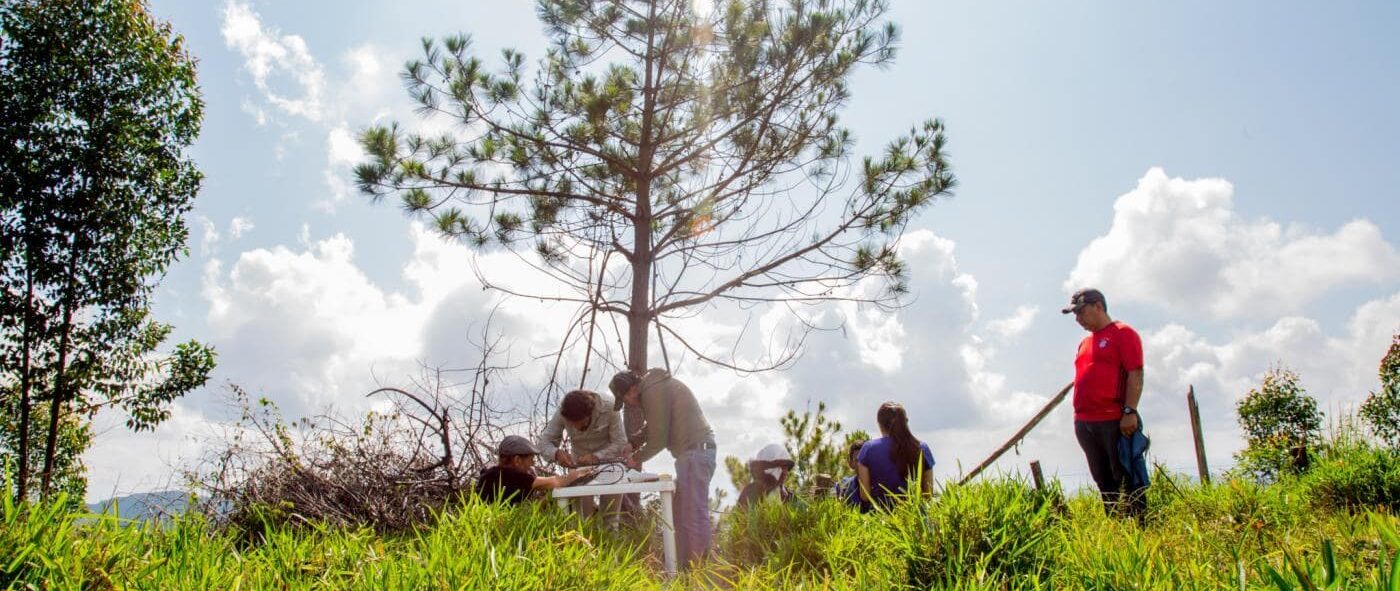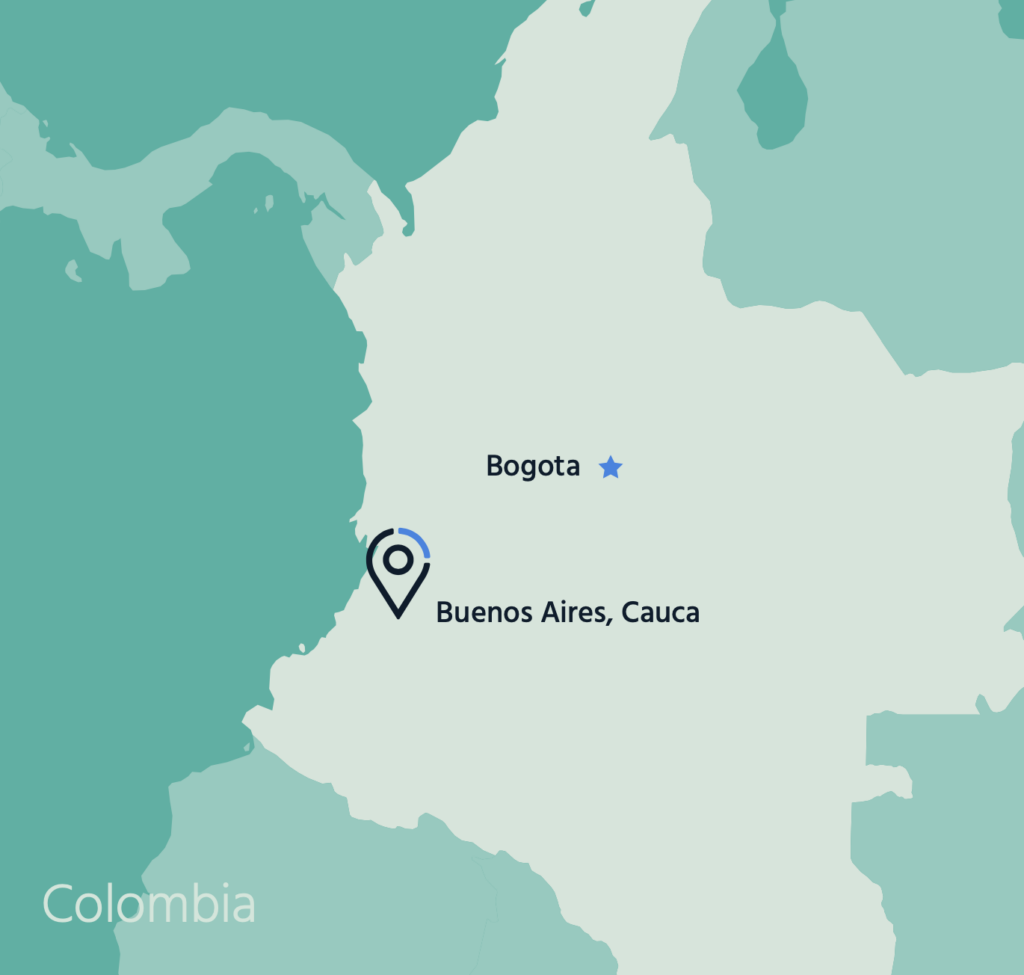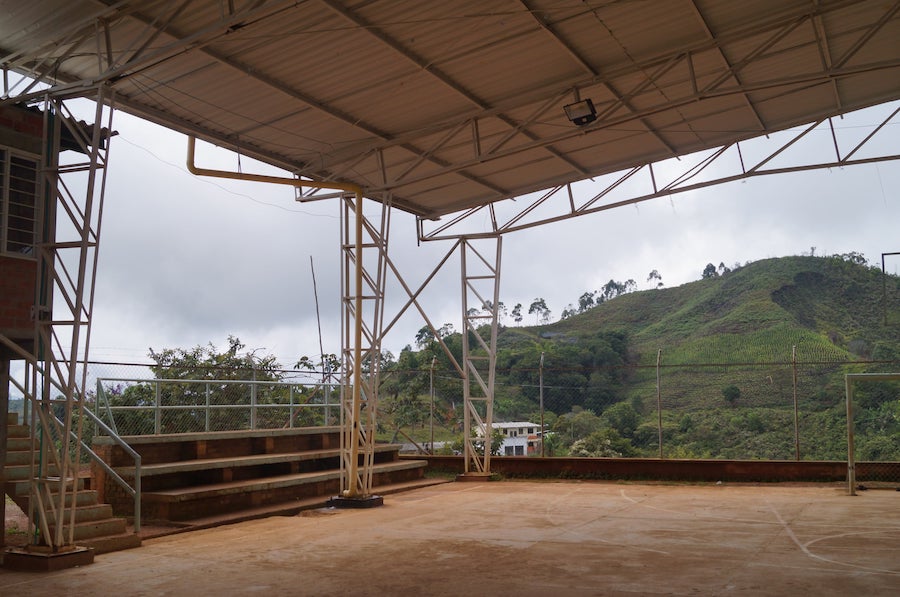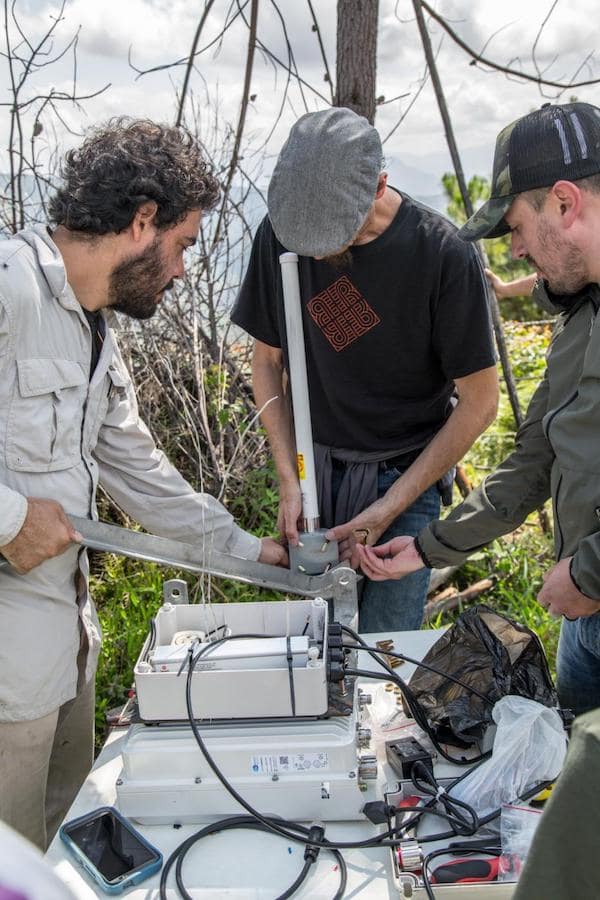September 2017
Colnodo meets with leaders from the rural areas of Buenos Aires.

In Buenos Aires, a rural town in Colombia, some residents go neighbor-to-neighbor to issue alerts. Cut off from the Internet and wireless services, they use a megaphone to announce community meetings. “That’s how it has always been,” says Claudia Andrea Guerrero, a 19-year-old woman who was born in a rural family and works in agriculture.
She’s almost right. In 2019 the community had a glimmer of hope: a pilot project that created a cellular network. It was made possible by an agreement with the Ministry of Information Technologies and Communications (MinTIC), which gave the green light for the community to access experimental radio spectrum frequencies at no cost. For the first time, residents could make calls and send text messages to each other.
But now the project—and the calls—have been put on hold. The MinTIC deal expired months into the COVID-19 pandemic, at a time the community needs it the most. The loss underscores how the right policies, not band-aids, are needed to keep communities online.
Buenos Aires, located in the Cauca Department of southwestern Colombia, has experienced its share of strife. The area was the site of the Cauca Department’s last massacre before the November 2016 peace agreement between the Revolutionary Armed Forces of Colombia (FARC) and the Government of Juan Manuel Santos—ending more than 50 years of internal conflict. Many residents have experienced violence directly. Like the rest of Cauca, there’s still a strong presence of armed groups in Buenos Aires.
“Northern Cauca is one of the most difficult territories the country has,” says Boris Guevara, a former FARC member. “If someone can figure out the formula to solve the conflict there, they will have the solution to the entire conflict in Colombia.”

Buenos Aires, adrift in connectivity
Buenos Aires is one of the fifteen municipalities that make up the north of Cauca. Its population of 35,000 is mostly made up by people of Indigenous and African ancestry. They work in agriculture and mining, since the region is known for fertile land and the abundance of gold. Although there is no exact data for Buenos Aires’ connectivity, in December 2020 the Colombian Ministry of Information Technologies and Communications (MinTIC) assured that Cauca had a connectivity index of 30%, and promised to reach 70% in 2022. For the first quarter of 2021, the department had 6.74 fixed Internet accesses for every 100 inhabitants. The average in Colombia is 15.72, and in Bogota, the capital city with almost 8 million inhabitants, it is 27.15.
The climatic and geographical conditions of Cauca have also historically made it difficult to deploy connectivity in the region. It is a mountainous hard-to-reach area with high rainfall. In Buenos Aires it is estimated that there are between 100 and 200 days of rain on average per year, frequently interrupting the supply of electricity.
“When the sky gets cloudy, the energy is already leaving. There are times when we go three, four, or five days without power,” says David Peña, former governor of the local La Paila-Naya reservation, which is home to 1,800 Indigenous people.
Following the 2016 peace accord, a rural area within Buenos Aires, La Esperanza, had been designated as a Territorial Training and Reincorporation Area (ETCR)—an area created to help reintegrate ex-guerrillas into civilian life. But by 2017 the area had little mobile coverage. Locals had to use very simple methods to communicate.
The communities requested greater connectivity from the government, but private operators had no plans to extend their coverage to Buenos Aires. They had already fulfilled their minimum expansion plans in the greater area, so the town was left behind.
Soon, scores of former combatants and diverse ethnic groups living in the region started meeting at La Esperanza’s sports center with a single focus. They wanted to bring connectivity to their rural communities, and so began the RedINC [INC Network] project.
It’s called RedINC because we were Indigenous, Black, and peasant people [Indígenas, Negros y Campesinos in Spanish] around a single table talking about a problem that affects us all.”
It wasn’t long before they heard about a project by Colnodo, an organization that leads social initiatives around the strategic use of the Internet.
People from Buenos Aires named their network RedINC, wich stands for Indigenous, Black, and peasant network in Spanish
At the time, Colnodo had been working with two organizations to implement a cellular community network in Colombia: Rhizomática and Redes por la Diversidad, Equidad y Sustentabilidad A.C. (Redes AC). Redes AC helped get the first social concession for Indigenous groups in Mexico. Due to the strong interest of residents, the lack of coverage, and the burgeoning re-socialization process that had begun there with ex-guerrillas, Buenos Aires was an ideal location to support a new network.
In September 2017, some 20 leaders from rural areas part of Buenos Aires, including El Silencio, La Esperanza, La Paila, El Ceral, and Agua Blanca, met with the Colnodo team to present their connectivity needs and to involve other residents, recalls Boris, who handled the communications of the ETCR at the time.
“I started trying to convince them that there were many factors about the network that could favor us […] people could transmit what was happening in the territory and stop being invisible. That was very important to us,” he says. The elders also hoped connectivity would keep young people from leaving the fields.
“Fortunately, here in the territory we have good communication between our leaders,” adds David. “We try to coordinate a lot in autonomous spaces and we managed to reach a consensus.”
Working closely with the Colnodo and Rhizomatica teams, the inhabitants of Buenos Aires learned about the possibilities community networks offer and participated in workshops to learn how to see their territory in a different way, which could help them identify strategic points for signal. They were supported by volunteer students from the University of Cauca and workshops provided by international organizations such as Redes AC and Telecomunicaciones Indígenas Comunitarias (Indigenous Community Telecommunications). As 2017 came to a close, they had installed the first tryout equipment for their cellular network.
But there was a stumbling block. The project required access to experimental spectrum frequencies, at no cost—for which they needed government approval. Colnodo eventually signed an agreement with the MinTIC that allowed them to access the spectrum on behalf of the government for a local GSM network in the 900MHz band. By then nearly two years had passed. It was April 2019.
The agreement didn’t include monetary aid, but RedINC, an idea built by the community in a sports center, moved forward with resources from the Internet Society, the Association for Progressive Communications (APC), and other external funds.

The sports center became the meeting point of the community and the place of operations of RedINC.
After several mishaps due to power outages and weather conditions in the area, the community managed to install three base stations by September of that year. The equipment, which made the 2G network operational, connected to the base station installed in the La Esperanza sports center, where the network is run. This place was chosen for its central location, but it also carries symbolic weight for a people who want to rebuild and heal the wounds left by violence. Esperanza means hope, after all.
“We find leaders with a great desire to work collectively, to show another side of their territory, and seek out tools that will allow young people to have other possibilities. They know that in the end it is they who manage to move the projects forward,” says Lilian Chamorro, a member of the Colnodo community networks team.
With the equipment in place, locals could finally make calls and send text messages for free within the network. By hiring a local Wi-Fi provider, RedINC was able to establish Internet access for the network, which allowed for better monitoring of the access points and enabled the community to make calls outside the network through Voice over Internet Protocol (VoIP).
The use of this service did not constitute a significant cost. In fact, people were willing to pay for a service that allowed them to communicate with family and friends outside the territory. Nevertheless, they experienced a setback when the government didn’t allow them to continue with VoIP tryouts after deeming it beyond the terms of the agreement.

RedINC had Wi-Fi service for a short period of time thanks to a partnership with a local service provider
MinTIC worried that the pilot would violate principles of interconnection of networks regulated by the Commission for the Regulation of Communications (CRC). The adjustments could also affect the formulation of the original agreement, which the ministry found problematic.
While the RedINC was active, residents of Buenos Aires were able to communicate with neighbors and relatives, as they all shared the same infrastructure.
“The people who were in the lowest part (of town) would call those in the highest part to ask questions or give emergency warnings. Many of us did not know how important communication was in our region,” says Claudia, who was among those in charge of maintaining the network and providing training on how to manage it in other rural areas. While they had the Internet service, she managed to complete two community networks diplomas, one from Mexico City and the other from Bogotá. She is currently working at various farms in Buenos Aires, but also wants to help reestablish RedINC and create similar projects throughout the region.
Many of us did not know how important communication was in our region.”
Claudia remembers people living in the most remote areas contacting store owners to see if certain products were available before making purchases. “The goal was for people to be more connected to one another. As communication here is so difficult, many can’t even speak to their families,” she says.
David, from the La Paila Reservation, agrees. “The project really had tremendous momentum. The community was very engaged and we could see that it was getting more and more interesting. We would call Cali or Bogotá (during tryouts), and that was very cool because that had never happened before,” he says.
RedINC facilitated communications between farms, the reservation, and the surrounding rural communities, practically functioning as a telephone system. The project worked with nearly 100 users who made more than 3,500 calls.
Despite its success, it went into a long hiatus in October 2020, when the MinTIC agreement concluded. Colnodo team could no longer make workshops on the countryside due to the COVID-19 pandemic, and new clashes between armed groups made the ex-guerrillas leave the municipality.
RedINC a été créé par la communauté, pour la communauté.
To connect to the Internet during the pandemic, some users in Buenos Aires were forced to hire local service providers that had started to penetrate the municipality. But not everyone can afford this crucial service.
“The service is expensive and in these pandemic times, most people made the effort to get Internet because students also need it to access classes remotely,” says Claudia.
Mobile telephony also remains deficient in the region and inhabitants can only be contacted by landlines.
“Before, I could move around the entire reservation. Everywhere I walked, I had a signal on my phone,” says David. Now he says many in the La Paila reservation have to make do with paper.
The advantage of these networks is that they are created by communities and adapted to their conditions.”
Colnodo, which has sought to ensure the future of the RedINC working with regulatory bodies, has encountered great difficulties in reactivating the project. In October 2020, the organization applied for another experimental license for six months before the MinTIC. By July 2021 there still wasn’t a favorable response from the ministry.
They also sent a proposal to participate in a regulatory “sandbox” of the Communications Regulation Commission (CRC). The sandbox is a trial regulation framework for certain projects for a limited time. The CRC seeks to adapt regulation to drive innovation in communications, especially in areas with low connectivity.
Through the sandbox, Colnodo proposed that regulations existing for community television could also be adapted for community cell phone and Internet networks. They wanted to install equipment to allow higher-speed and more reliable LTE connections in Buenos Aires, which would have brought Internet service to mobile phones. It was expected that at the end of this pilot project, MinTIC would have the information it needed to start drafting new regulations that can benefit other community networks.
However, the time-consuming participation process came to an end in August 2021, when the CRC determined that the project did not meet the “demonstrated need” criteria.
According to Julián Casasbuenas, Director of Colnodo, even though the proposal was legitimate, the process failed because the CRC could not grant them permission to use the spectrum, since that is MinTIC’s responsibility.

RedINC was built by the community, for the community.
“It is a bit ironic that in order to apply to the sandbox, which evaluates new projects to modify the regulations, they ask the proponent to present a MinTIC permit. In practical terms, the network cannot be turned on, it cannot operate with the technology that we considered in the sandbox. It was a very good opportunity to advance innovation in the country,” says Casasbuenas.
These difficulties are closely linked to the ambiguous space community networks occupy in Colombia. Today they are not considered as actors in the telecommunications ecosystem, therefore, there are no guidelines for them to operate their services. Nor are they allowed access to seed capital or to resources from Fontic, the government’s fund that seeks to finance plans, programs, and projects to facilitate universal access to ICT. Yet these projects are essential when it comes to bringing connectivity to hard-to-reach areas, such as Buenos Aires.
The advantage of these networks is that they are created by communities and adapted to their conditions. This is something you can’t ask of a commercial operator, who works in a standardized way. The RedINC was a very nice process; it was an opportunity to see these communities working together, assessing their territory, their problems, characteristics, and dreams. It is from that starting point that a network develops, not the other way around”
Involvement from organizations such as the Internet Society has helped lay the groundwork for the development of state policies and to support these types of initiatives. According to Lilian, they are a first step to “entering into more horizontal dialogues” with the government and local authorities.
“With Buenos Aires the spectrum that was contemplated only for large operators could be accessed for the benefit of a small community,” says Christian O’Flaherty, the Internet Society’s Regional Vice-President for Latin America and the Caribbean.
In fact, the Colombian case shows one of the main problems faced by community networks in Latin America: access to the radioelectric spectrum. Except in countries like Mexico, there are almost no policies that include them in frequency assignment processes. These networks could be more widely deployed if there were more flexible regulations, with access to shared infrastructure, or through the implementation of public policies that facilitate financing methods. These initiatives complement existing networks, they don’t compete with them
“The big operators did a great job in connecting a lot of people in cities and in the most populated areas. But now, half of the population is still not connected. We have to think of innovative ways to connect those people,” says Juan Peirano, Senior Policy Advisor at Internet Society. “In Latin America, governments and regulators are making great efforts to acknowledge this situation and take appropriate action.”
O’Flaherty stresses that regulatory changes could help reduce the digital divide. “The current model does not work in 100% of cases. Regulatory changes are needed so that these communities can take initiative. Governments have to recognize this as a need and an opportunity,” he says. In the case of Buenos Aires, “If the neighbors themselves hadn’t built the network, no one else was going to do it.”
One of the last chances for the community of Buenos Aires is a law that was passed in July 2021 that established Internet as an essential and universal public service in Colombia. The CRC has 10 months to regulate this decision, so community networks could still be considered in national regulations and be taken seriously with larger projects.
For the moment, Colnodo will try to relocate some Internet equipment that does not need a license so that the community of Buenos Aires can use it. The devices that give the signal through cell phones will remain off until they have a new opportunity to access the Colombian radioelectric spectrum.
“It is not only our community that is disconnected, there are many communities that have no means of communication,” says Claudia. “The network was a learning experience that was very useful for our region while it lasted.”
In the meantime, the people of Buenos Aires will continue waiting for their pilot project to return for good—as a permanent network.
“Here we still use letters and billboards. We use them because the service is no good. That’s why we hedged our bets on something better; we wanted to innovate here in the territory. Hope is the last thing to be lost,” says David.
September 2017
Colnodo meets with leaders from the rural areas of Buenos Aires.
December 2017
The community participates in the structuring of the INC community network and the cellular network with test devices.
May 2018
The community network committee is formed.
August 2018
The planning of the Internet network begins, as well as coworkshops on the use of the internet for people of all ages.
September 2018
La Esperanza obtains Internet connection to fiber optic network in the urban area of Buenos Aires. The community set up a 12km link to carry out the connection to the path through a hilly area that could serve as backhaul for a wireless network.
December 2018
The community installs a mesh network and point-to-point connections.
April 2019
Colnodo signs an agreement that allows the community to access the spectrum on behalf of the MinTIC for a local GSM network in the 900MHz band. The INC cellular network begins operating as an experimental network for one year.
April 2020
An extension of the operation for six months is requested.
October 2020
The agreement with MinTIC comes to an end and the cellular network is turned off.
May 2021
Colnodo’s proposal gets through the first stage of the CRC’s “Sandbox”.
July 2021
Colombia issued a law that establishes the Internet as an essential and universal public service.
August 2021
CRC rejects Colnodo’s proposal, finding that it did not meet the “demonstrated need” criteria.
All photos are courtesy of Colnodo.